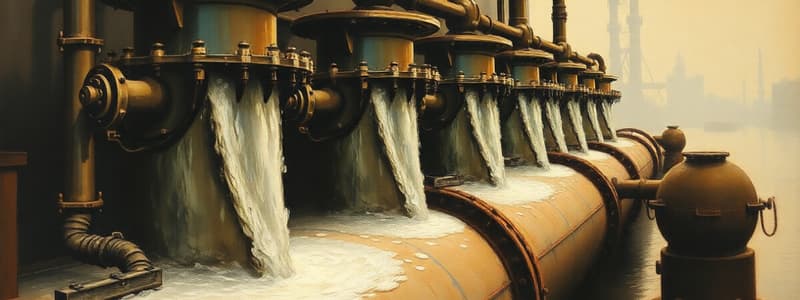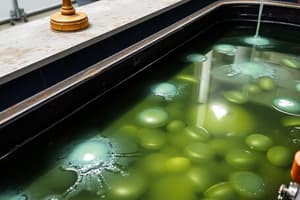Podcast
Questions and Answers
What is the main purpose of D-310A/B reactors?
What is the main purpose of D-310A/B reactors?
To separate cooled reactor effluent into a liquid product stream and a recycle ethylene vapor stream.
Where does the recycle ethylene vapor stream exit in D-310A/B separators?
Where does the recycle ethylene vapor stream exit in D-310A/B separators?
It exits from the top of the separators.
What is the role of T-330 (TEA Scrubber) in the process?
What is the role of T-330 (TEA Scrubber) in the process?
To remove aluminum alkyls that could cause plugging in downstream equipment.
How does the C10-12 stream function in relation to the TEA Scrubber?
How does the C10-12 stream function in relation to the TEA Scrubber?
What maintenance might be required for T-330 (TEA Scrubber)?
What maintenance might be required for T-330 (TEA Scrubber)?
What type of heat exchangers are E-330A/B, and what is their primary function?
What type of heat exchangers are E-330A/B, and what is their primary function?
When would E-330A/B coolers be taken out of service?
When would E-330A/B coolers be taken out of service?
What feature of D-330 (H.P. Recycle K.O. Pot) helps separate liquid from vapor?
What feature of D-330 (H.P. Recycle K.O. Pot) helps separate liquid from vapor?
From where does the ethylene enter the D-330 K.O. Pot?
From where does the ethylene enter the D-330 K.O. Pot?
What exits from the bottom of the D-330 K.O. Pot?
What exits from the bottom of the D-330 K.O. Pot?
Study Notes
Reactor Effluent Separators (D-310A/B)
- Dimensions: 8 feet diameter, 28 feet 8.3125 inches length.
- Separates cooled reactor effluent into two streams: liquid product and recycle ethylene vapor.
- Liquid product exits from the bottom; recycle ethylene vapor exits from the top of the separators.
- One separator operates while the other remains in standby, held under nitrogen pressure for air removal.
TEA Scrubber (T-330)
- Dimensions: 3 feet diameter, 23 feet 6 inches length.
- Removes aluminum alkyls to prevent downstream equipment plugging due to ethylene polymerization.
- C10-12 stream from the recycle ethylene vapor stream inhibits aluminum alkyl reactions.
- Recycle ethylene vapor enters from the side bottom and C10-12 enters from the side top; vapor exits from the top, liquid from the bottom.
- Periodic cleaning may be required due to potential fouling; equipped with Teflon impregnated valves to reduce fouling.
- Bypass capability for clean-up; each tray has a manway for easier access during cleaning.
Ethylene Recycle Coolers (E-330A/B)
- Multi-tube U-type heat exchangers for cooling ethylene vapor using cooling water.
- Typically, both coolers operate simultaneously.
- When efficiency declines (indicated by increasing effluent temperatures), the fouled cooler is taken offline for cleaning.
High-Pressure Recycle Knock-Out Pot (D-330)
- Dimensions: 3 feet 6 inches diameter, 7 feet 9 inches length.
- Features an internal demister pad to remove entrained liquid from ethylene during cooling.
- Ethylene enters the pot from the side, with liquid exiting from the bottom and vapor from the top.
Studying That Suits You
Use AI to generate personalized quizzes and flashcards to suit your learning preferences.
Description
This quiz covers the operation and design of D-310A/B Reactor Effluent Separators. You'll learn about the separation process of cooled reactor effluent into liquid and vapor streams. Test your knowledge on the functionality and configuration of these critical systems.




